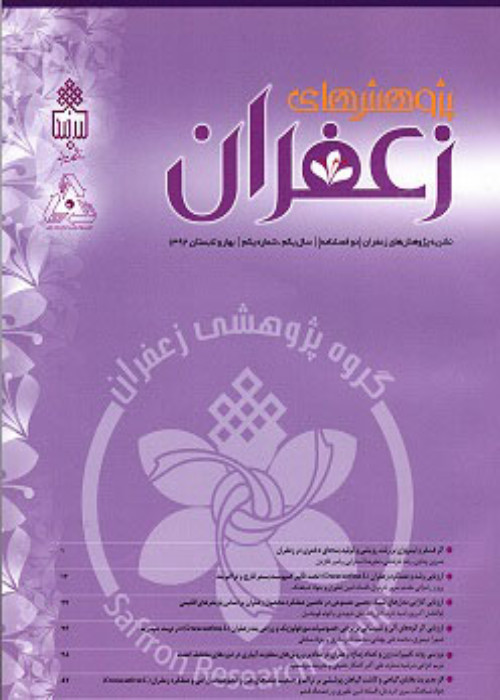Effect of application of biological and chemical potassium fertilizer and corm weight on physiological traits and flower yield of saffron (Crocus sativus L.)
Author(s):
Article Type:
Research/Original Article (بدون رتبه معتبر)
Abstract:
Introduction
Potassium is the most abundant inorganic cation in plant tissues that plays a major role in physiological processes, especially in growth and metabolism. Although there is substantial evidence about the effects of potassium fertilizer on increasing the qualitative and quantitative yield of plants, little is known about the effects of applied potassium on saffron and the improvement of the quality and yield of the saffron flower. The purpose of this study was to evaluate the effects of biological and chemical potassium fertilizer and corm weight on some physiological traits and yield of saffron (Crocus sativus L.). Materials and Methods
An experiment was conducted as factorial based on a randomized complete block design with three replications and eight treatments at the saffron research field of the College of Aburaihan, the University of Tehran during 2015-2016. Experimental treatments included two levels of potassium sulfate fertilizer (0 and 200 kg. ha-1) as the first factor, two levels of Potabarvar-2 biofertilizer (0 and 100 g. ha-1) as the second factor, and two corm weights including small (3-5 g) and big (8-10 g) were the third factors. Potabarvar-2 biological fertilizer used in the research has a set of the most effective potassium-releasing bacteria called Pseudomonas spp. Strain s19-1 and Pseudomonas spp. strain s14-3, which was inoculated with corms before cultivation. Potassium chemical fertilizer treatment of potassium sulfate type and in the amount of 200 kg per was used as pre-planting in the soil of the desired plots. The corms were planted at a distance of 10 cm on the row at a depth of 15 cm at the end of June. In order to increase the colonization of bacteria around the corm, irrigation was done after planting and then summer irrigation was done on the first of September, the appearance of the first flower was at the beginning of November and the end of flowering was in the middle of December. In this research, functional traits including the number of flowers, flower fresh weight, stigma dry weight, and physiological traits including petal anthocyanin, leaf soluble protein, and total leaf soluble carbohydrate were measured. Results and Discussion
the results of this experiment indicated that the application of potassium, especially in the form of biofertilizer, had positive effects on improving flowering and increasing the number of flowers in both groups of saffron corms, especially small corms (3-5 grams). Also, the increase in the fresh weight of flowers was evident in the combined application of biological and chemical fertilizers, especially in large corms (8-10 grams). Stigma dry weight increase as an important component of saffron performance was affected by the application of chemical fertilizer, although biological fertilizer also caused a significant increase in this functional trait compared to the control. The application of potassium sulfate in combination with biological fertilizer had the greatest effect on increasing the concentration of total carbon hydrates, total leaf protein, and petal anthocyanin content. Therefore, in most of the measured traits, biofertilizer has positive effects, and to achieve the maximum flower yield and quality of saffron per unit area, biofertilizer alone (100 grams per hectare) or in combination with smaller amounts of potassium sulfate chemical fertilizer should be used. Applied fertilizers led to increasing in flower yield through an enhancement in the number of flowers, fresh weight of flower, and dry weight of stigma. Application of biological fertilizer alone led to an increase of three times the number of flowers in a big corm in comparison with a small corm and normal. There was a significant difference between normal treatment and application of both mixed fertilizers on the concentration of total carbohydrate and protein of the leaf and anthocyanin of the petal. Conclusion
In summary, the results of this experiment indicated that the application of big corms by inoculating them with biological fertilizer of potassium, in addition to using smaller amounts of potassium sulfate chemical fertilizer before sowing would be affected the increase of flower yield and improve physiological traits effectively growth. Therefore, the use of biological potassium fertilizer led to a decrease of using of chemical fertilizers and will be promising for sustainable agriculture and reducing the environmental pollution.Keywords:
Language:
Persian
Published:
Journal of Saffron Research, Volume:10 Issue: 2, 2022
Pages:
215 to 230
magiran.com/p2554457
دانلود و مطالعه متن این مقاله با یکی از روشهای زیر امکان پذیر است:
اشتراک شخصی
با عضویت و پرداخت آنلاین حق اشتراک یکساله به مبلغ 1,390,000ريال میتوانید 70 عنوان مطلب دانلود کنید!
اشتراک سازمانی
به کتابخانه دانشگاه یا محل کار خود پیشنهاد کنید تا اشتراک سازمانی این پایگاه را برای دسترسی نامحدود همه کاربران به متن مطالب تهیه نمایند!
توجه!
- حق عضویت دریافتی صرف حمایت از نشریات عضو و نگهداری، تکمیل و توسعه مگیران میشود.
- پرداخت حق اشتراک و دانلود مقالات اجازه بازنشر آن در سایر رسانههای چاپی و دیجیتال را به کاربر نمیدهد.
In order to view content subscription is required
Personal subscription
Subscribe magiran.com for 70 € euros via PayPal and download 70 articles during a year.
Organization subscription
Please contact us to subscribe your university or library for unlimited access!




